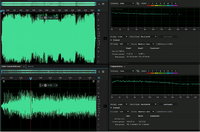Glued to the PCB, not to the case. My understanding is that you can disassemble it as you want, the "boom cage" just sticks to the PCB and the speaker's membrane sticks to the case ?
that makes more sense, i guess i misunderstood ED
Glued to the PCB, not to the case. My understanding is that you can disassemble it as you want, the "boom cage" just sticks to the PCB and the speaker's membrane sticks to the case ?

1. The driver is loose, rattling on its own.
2. The driver is catching on the grille at low frequency xmax
3. The driver is catching on the PCB at low frequency xmax
4. The driver is front-loaded by the grille, turning it into a compression-driver
5. The front case as a baffle is a problem
6. The front waveguide is a problem
7. The front speaker grille is a problem
8. The back waveguide is a problem
9. The diffraction against the PCB is a problem
10. The space for the back of the driver is a problem, could be standing waves, could be many things
11. The openings for ports, battery compartment seal (etc) in the back of the case is a problem
free air
Provided we get this far, and assuming ideal working conditions, try the following first with the driver sealed into place with silicone along its edges, then again like that, only now with the front grille completely removed.
- try the driver outside the case, radiating into full space
bass-reflex
- try sealing off some but not all off the openings in the case
Could also try the GPD drivers or pandora drivers in known to work or these conditions, or,
move the pyra drivers to the pandora or the GPD.
If you do a frequency sweep you can see what happens to the resonant frequency for all of these things.
From what i could see on the pictures it looked like the back volume was almost completely sealed.
The low frequencies taper off, and the high frequencies are lost, more alarmingly;

I'm very surprised that the GPD sounds so terrible
After owning a GPD G5A, I'm not. Their build quality is absolutely terrible. Wouldn't be surprised if it has two different speakers, whatever they pulled out of the box that day. Ah man, I shouldn't be so negative. I just have a sour taste in my mouth after that fiasco.
My Headphones are able to controll the Musik Playback from my Ipod Touch 5, so if this also works whit Pyra, this would be great..
Mainly the Bluetooth things that works with Apple things, does not work with everything else... but maybe you are lucky and the Pyra driver could be hacked someway
This is perfekt, because i want my Pyra to akt also as an Mp3 Player for Sport, whit a big SD Card..
The Question is, how good dos a Bluetooth Headphone work out of the box..
My Headphones are able to controll the Musik Playback from my Ipod Touch 5, so if this also works whit Pyra, this would be great..

